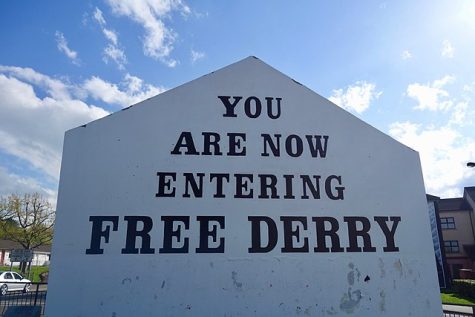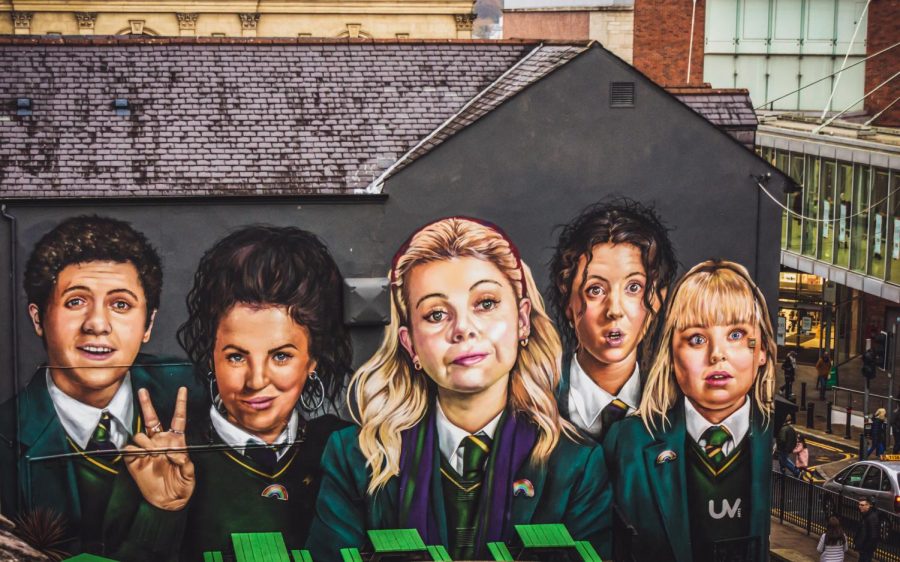“Derry Girls” and Comedy Within Conflict
A summary of the hit Northern Irish TV series, its connection to the Troubles, and impact on the country
Murals have long been a symbol of pride in identity and history within Northern Ireland. Now, the TV series “Derry Girls” goes down in Derry history with its own mural of (from left) James, Michelle, Erin, Orla, and Claire in city center.
Sectarian conflict and teen comedy may seem at odds, but the TV series Derry Girls manages to combine the two. Set in the 1990s in Derry, Northern Ireland, the show follows four Catholic teenage girls, Erin, Orla, Claire, Michelle, and their “wee English fella” friend, James. Erin is awkward, self-conscious, and dying to fit in, but underneath her pursuits for popularity, she is a hopeful writer and cares deeply. Her cousin, Orla, is an oddball but loveable member of the group with a passion for step aerobics. Claire is studious and driven, and though the shenanigans of her friends are constantly testing her nerves, she remains an unshakeable member of the group. Michelle is boy-crazy and always gets her friends into trouble, but she is fiercely loyal. Finally is James, the kind-hearted, nerdy cousin of Michelle, who the others endlessly tease on account of him being English.
Despite its typical teenage characters, the presence of political and religious conflict in their lives is a defining aspect of the show. Derry Girls is set towards the end of the Troubles, a period of violent conflict in Northern Ireland born out of centuries-old tensions between Catholics and Protestants on the Emerald Isle that reflect a larger political struggle between Irish and British identity. These tensions reached a boiling point after the partition of Northern Ireland and the Republic of Ireland, separating the island into two countries. The partition also consolidated an Anglo-Protestant majority in the north, leading to heightened tensions with the Irish Catholic minority. Debates between nationalists (supporters of the reunification of Ireland) and unionists (supporters of remaining an extension of the U.K.) are intertwined with these religious sects, with Catholics being primarily nationalist and Protestants being primarily unionist.

In short, the situation in which the Troubles arose is complex and one that I cannot explain fully to include all the nuance. The bottom line is that it involved tensions surrounding national, ethnic, and religious identity that boiled over into violence in the 1960s. The Troubles would span three decades and did not officially end until 1998, after the deaths of more than 3,500, with many of the casualties being civilians. The setting of the TV series, Derry, is seen as the starting point of the conflict with the Battle of Bogside in 1969. Three years later, it was the location of one of the deadliest instances violence during the Troubles in 1972. In what has become known as Bloody Sunday, a march in Derry by the Northern Ireland Civil Rights Association ended in the death of fourteen people after the police opened fire on a crowd.
But this history is what sets Derry Girls apart from other teenage comedies. From the beginning of the pilot episode, the Troubles is established as a part of day-to-day life for the teenagers who have never known Northern Ireland without it. Within this perceived normalcy, however, is humor which creator Lisa McGee has used to turn Derry Girls into an international hit. On the morning of their first day of school term, the girls are delayed in their trip to school when a bomb threat from a paramilitary group closes one of the bridges in Derry. To outsiders, the enormity of the situation is hard to ignore, but for the Quinn and McCool family, it is just another obstacle in their day. In a particularly humorous moment, Sarah, Erin’s aunt, complains that the bomb is going to cause her to miss her tanning appointment. Erin is quick to quip back: “I’m pretty sure interfering with your sunbed sessions isn’t high up on anyone’s political agenda, Aunt Sarah.”
Moments like this are scattered throughout the series, with the characters ending up in situations that are distinct products of their country’s political climate: road tripping across the border to avoid the yearly unionist parades, attending an outdoors camp for Catholic and Protestant teenagers geared towards reconciliation, and stopping at army checkpoints every morning before school. However, despite the Troubles being a unique part of the show, Derry Girls does not shy away from indulging in typical teen comedy plots either. Often, the Troubles simply become a backdrop for the show and the universal teenage experiences of the characters that seek independence from their parents, relationships, and success in school, all while finding a sense of self.

The Troubles, and Northern Ireland as a whole, are complicated and particularly difficult to fully understand for foreigners, but Derry Girls puts the country on the map for a different, more positive reason. Since its creation, Northern Ireland has been defined by its sectarian conflict, but this show provides a glimpse into its impact on the ordinary people that are not so unlike the families or teenagers of the rest of the world. For many Northern Irish, especially those from Derry, the show has been a source of pride. In an interview with The Guardian, Derry drama teacher who taught two of the show’s actresses, Saoirse-Monica Jackson (Erin) and Jamie-Lee O’Donnell (Michelle), said of the show: “It’s the light that it brings. It’s Derry in color, not in black and white.” Creator and writer of Derry Girls, Lisa McGee echoed this remark in the same article, stating the show illustrates another side to life in Northern Ireland: “Something about comedy makes things accessible to people. It’s shown a side of the place that has not been shown an awful lot, for instance the more ridiculous elements of day-to-day life…I hope that will be the legacy of Derry Girls, that other people will write about here.”
The third and final season of Derry Girls is currently premiering in the United Kingdom and Ireland, with an episode releasing each Tuesday until May 17th. The final season will span six episodes and is expected the be released on Netflix later this year.




